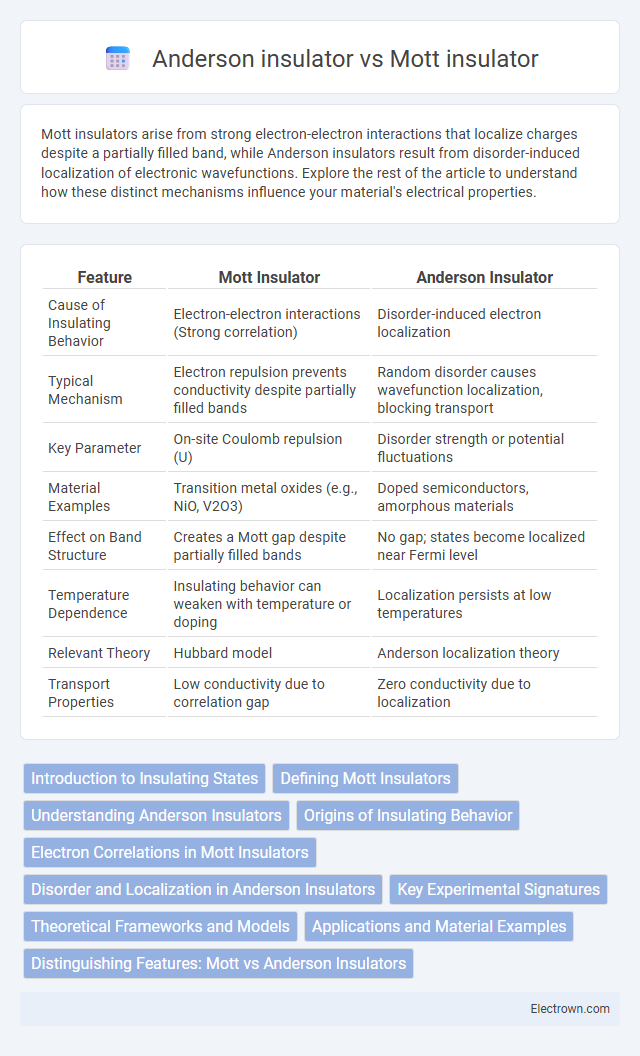Mott insulators arise from strong electron-electron interactions that localize charges despite a partially filled band, while Anderson insulators result from disorder-induced localization of electronic wavefunctions. Explore the rest of the article to understand how these distinct mechanisms influence your material's electrical properties.
Table of Comparison
| Feature | Mott Insulator | Anderson Insulator |
|---|---|---|
| Cause of Insulating Behavior | Electron-electron interactions (Strong correlation) | Disorder-induced electron localization |
| Typical Mechanism | Electron repulsion prevents conductivity despite partially filled bands | Random disorder causes wavefunction localization, blocking transport |
| Key Parameter | On-site Coulomb repulsion (U) | Disorder strength or potential fluctuations |
| Material Examples | Transition metal oxides (e.g., NiO, V2O3) | Doped semiconductors, amorphous materials |
| Effect on Band Structure | Creates a Mott gap despite partially filled bands | No gap; states become localized near Fermi level |
| Temperature Dependence | Insulating behavior can weaken with temperature or doping | Localization persists at low temperatures |
| Relevant Theory | Hubbard model | Anderson localization theory |
| Transport Properties | Low conductivity due to correlation gap | Zero conductivity due to localization |
Introduction to Insulating States
Mott insulators arise from strong electron-electron interactions that localize electrons despite a partially filled conduction band, leading to an insulating state due to electron correlation effects. Anderson insulators occur when disorder in a system causes localization of electron wave functions, preventing electrical conduction even without electron interactions. Understanding the difference between these insulating states helps you explore how electron correlations and disorder independently impact material conductivity.
Defining Mott Insulators
Mott insulators are materials where strong electron-electron interactions prevent electrical conductivity despite an otherwise partially filled conduction band predicted by band theory. The localization of electrons arises from Coulomb repulsion, leading to a correlation-driven insulating state that cannot be explained by conventional band theory alone. This electron correlation distinguishes Mott insulators from Anderson insulators, where disorder-induced localization causes the insulating behavior.
Understanding Anderson Insulators
Anderson insulators are materials where electron localization occurs due to disorder-induced scattering, preventing electronic conduction despite available energy states. Unlike Mott insulators, which rely on strong electron-electron interactions and Coulomb repulsion to inhibit conductivity, Anderson insulators result from randomness and impurities disrupting wavefunction coherence. Understanding Anderson insulators is crucial for exploring quantum transport phenomena in disordered systems and designing materials with tailored electronic properties.
Origins of Insulating Behavior
Mott insulators arise from strong electron-electron interactions that localize electrons despite partially filled bands, leading to an insulating state due to electron correlation effects. Anderson insulators result from disorder-induced localization, where random impurities or defects prevent electron conduction by disrupting wavefunction overlap. Understanding these distinct origins of insulating behavior helps you identify whether electron correlation or disorder dominates in a given material.
Electron Correlations in Mott Insulators
Mott insulators exhibit strong electron correlations that localize electrons despite partially filled bands, leading to insulating behavior contrary to band theory predictions. Electron-electron repulsion in Mott insulators creates a charge gap by splitting energy bands into lower and upper Hubbard bands, preventing electron mobility. In contrast, Anderson insulators localize electrons due to disorder-induced scattering without significant electron correlations, resulting in a different insulating mechanism.
Disorder and Localization in Anderson Insulators
Anderson insulators exhibit localization due to strong disorder, where random potential fluctuations prevent electron wavefunctions from spreading, causing electrons to become spatially confined. Unlike Mott insulators, where electron-electron interactions open a gap in the electronic spectrum, Anderson insulators rely on disorder-induced localization without requiring interactions. Your understanding of electronic transport must consider that in Anderson insulators, increasing disorder enhances localization, suppressing conductivity through quantum interference effects.
Key Experimental Signatures
Mott insulators exhibit a gap in the electronic density of states due to strong electron-electron interactions, leading to a temperature-dependent resistivity that increases sharply at low temperatures and can be characterized by spectroscopic evidence of correlation-induced gap features. Anderson insulators, in contrast, show localization of electronic states caused by disorder without an energy gap, resulting in variable-range hopping conduction and a lack of metallic behavior even at zero temperature. Experimental techniques such as angle-resolved photoemission spectroscopy (ARPES) reveal distinct band structure modifications in Mott insulators, whereas Anderson insulators display spatially localized wavefunctions confirmed through scanning tunneling microscopy (STM) and transport measurements.
Theoretical Frameworks and Models
Mott insulators are described by the Hubbard model, which emphasizes electron-electron interactions leading to localized electrons despite a partially filled band. Anderson insulators are explained through Anderson localization theory, where disorder-induced interference causes electron wavefunctions to become spatially localized, preventing conduction. Both models highlight different mechanisms for insulating behavior: strong correlation effects in Mott insulators versus disorder-driven localization in Anderson insulators.
Applications and Material Examples
Mott insulators, exemplified by transition metal oxides like NiO and V2O3, are crucial in applications such as high-temperature superconductors and spintronic devices due to their electron correlation-driven insulating behavior. Anderson insulators, often found in doped semiconductors or amorphous materials like doped silicon and indium oxide, are important for understanding disorder-induced localization relevant to electronic components and sensor technologies. Your choice between these materials depends on the need for strong electron interactions in Mott insulators or disorder-induced localization effects typical of Anderson insulators.
Distinguishing Features: Mott vs Anderson Insulators
Mott insulators arise from strong electron-electron interactions causing localized electrons despite partially filled bands, while Anderson insulators result from disorder-induced electron localization without necessarily strong interactions. The key distinguishing feature is that Mott insulators exhibit a correlation-driven energy gap, whereas Anderson insulators display localization through random potential fluctuations disrupting electronic wavefunctions. Experimental observations of conductivity and spectral properties help differentiate these insulating states, with Mott insulators showing a correlation gap and Anderson insulators characterized by a mobility edge in disordered systems.
Mott insulator vs Anderson insulator Infographic

 electrown.com
electrown.com